Cold process soap cures best at temperatures between 65°F and 75°F (18°C to 24°C). You'll want to avoid temperatures above 80°F, which can cause Dreaded Orange Spots (DOS), and below 60°F, which slows curing and creates softer bars. Keep your curing environment's temperature stable throughout the entire curing period, with humidity levels below 60%. Temperature consistency matters more than achieving perfect conditions. The right environment transforms your homemade soap from good to exceptional.
The Ideal Temperature Range for Cold Process Soap Curing
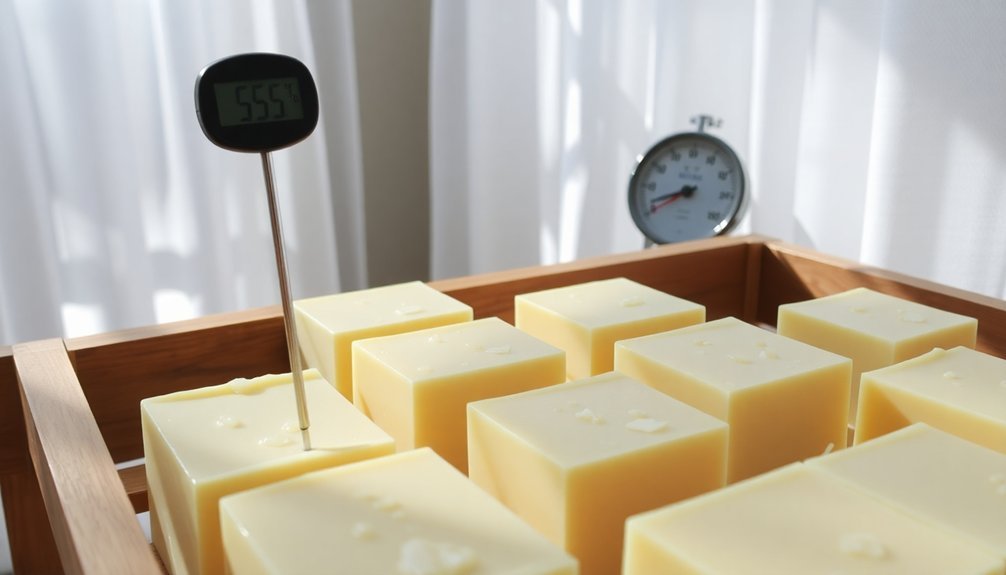
While many factors influence the success of cold process soap making, maintaining the proper temperature during curing is essential for achieving high-quality results.
Your soap performs best when cured between 65°F and 75°F (18°C to 24°C), creating the perfect environment for proper drying and hardening.
If your curing area exceeds 80°F (27°C), you'll risk developing DOS (Dreaded Orange Spots), even though the curing process may accelerate.
Conversely, temperatures below 60°F (15°C) will slow curing and potentially leave you with softer bars.
For best results, aim for temperature stability throughout the curing period.
While soaps can safely cure up to the mid-80s Fahrenheit in dehumidified spaces, maintaining the ideal range ensures consistent quality and prevents deformities in your finished products.
Using a digital laser thermometer can help you accurately monitor your curing environment to maintain optimal conditions.
How Room Temperature Affects Your Soap's Final Quality
The temperature of your curing space directly impacts your soap's final appearance, texture, and overall quality.
Curing in cooler environments slows down hardening but doesn't affect the overall curing timeline. Conversely, warmer rooms naturally encourage gel phase, which can enhance color vibrancy but risks overheating your soap.
Humidity levels in your curing space are equally important:
- High humidity environments slow down the curing process considerably.
- Dry conditions accelerate water evaporation and curing time.
- Excessive heat can lead to glycerin rivers or soda ash formation.
- Temperature fluctuations may affect the final texture of your soap.
For best results, aim for a consistent room temperature between 60-80°F with moderate humidity. Avoiding situations that might cause false trace will ensure your soap cures properly without developing a grainy texture.
This balanced environment allows proper curing while avoiding common temperature-related issues.
Seasonal Temperature Variations and Curing Adjustments
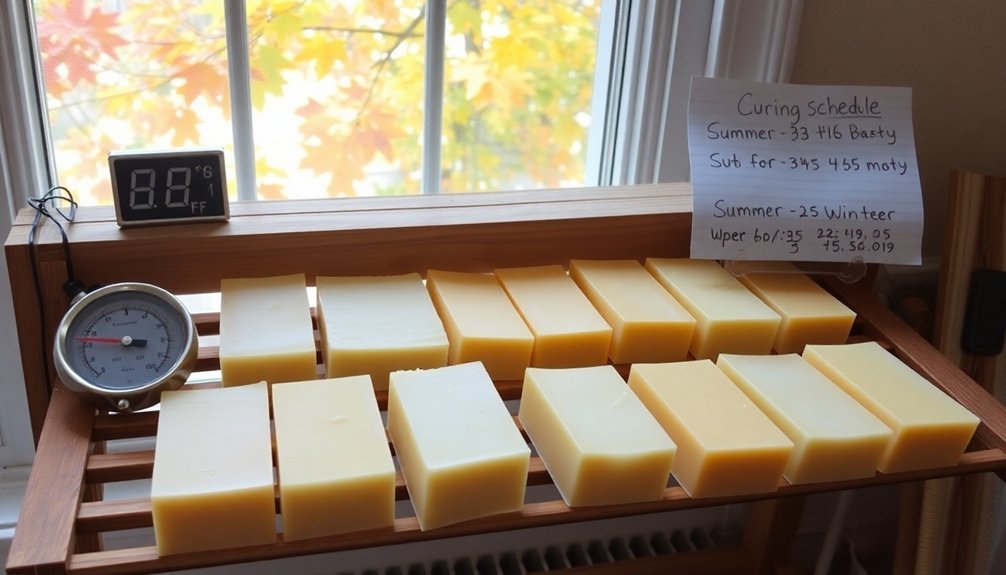
You'll need to adapt your curing process as seasons change, with winter requiring extra time (6-8 weeks) and summer demanding protection against excessive drying.
Managing humidity becomes essential during wet months, where you can use fans to increase air circulation and prevent moisture-related curing problems.
Consider using simple insulation methods like cardboard boxes or towels to maintain consistent temperatures and shield your soap from the extreme fluctuations that can compromise quality. Remember that soap cures at the same rate regardless of ambient temperature, though cold environments may slow down the initial hardening process.
Seasonal Impact Solutions
Seasonal temperature variations can greatly affect your cold process soap curing results, requiring thoughtful adjustments throughout the year.
Creating a consistent curing environment will help guarantee your soaps harden properly and develop the mild characteristics you're looking for.
To maintain ideal curing conditions regardless of season:
- Summer strategy – Use fans for air circulation and consider a dedicated curing space away from direct heat sources to prevent soap from curing too quickly. Remember that unlike hot process soap, cold process soap requires several weeks of cure time to achieve optimal quality and hardness.
- Winter approach – Add insulation around curing areas or use a curing box with a small heat source to maintain 70-85°F (21-29°C).
- Transitional seasons – Monitor temperature fluctuations closely and adjust covering/insulation as needed.
- Year-round solution – Install a thermometer in your curing area for consistent monitoring and early problem detection.
Humidity Mitigation Techniques
Controlling humidity remains just as essential as managing temperature when curing cold process soap, since excessive moisture can greatly delay hardening and potentially introduce mold growth.
For best results, aim to keep humidity levels below 60% in your curing area.
You'll find several effective strategies to combat excess moisture. Place desiccants near your curing soaps to absorb ambient humidity, or use dehumidifiers in particularly damp environments.
Space your soap bars adequately on curing racks to promote airflow between them – crowded soaps trap moisture and cure unevenly.
If you don't have specialized equipment, simple solutions work well: position a small fan to create gentle circulation, use air conditioning during humid months, and regularly rotate your soaps to guarantee uniform drying throughout the curing process. Remember to always wear safety equipment like goggles and gloves when handling your soaps during the rotating process.
Temperature vs. Humidity: Finding the Perfect Balance
While maintaining the ideal 70-75°F temperature range for curing, you'll also need to balance humidity levels between 50-70% for properly hardened soap.
You can control moisture with open windows for better airflow, dehumidifiers in damp climates, or humidifiers in excessively dry regions. Remember that soap temperature preferences vary based on recipe complexity and desired patterns, just as curing conditions do.
Your geographical location may require specific adjustments—coastal soapmakers might need extra drying time, while desert crafters should protect their batches from drying too quickly.
Ideal Temperature-Humidity Ratio
Finding the perfect balance between temperature and humidity creates suitable conditions for cold process soap curing.
While temperature should stay between 70°F-85°F (21°C-29°C), you'll want to maintain relatively low humidity levels to prevent moisture absorption and DOS (dreaded orange spots).
For best curing results, follow this temperature-humidity ratio guide:
- Ideal environment: 75°F (24°C) with 40-50% humidity offers the perfect balance for most soap formulations.
- Temperature consistency is more essential than perfect humidity control.
- Lower humidity (30-45%) benefits soaps with milk, honey, or high oil content.
- Seasonal adjustments may be necessary—use dehumidifiers in summer and maintain steady temperatures in winter. Just as anthropologists examine how cultural adaptation influences resource utilization, soap makers must adapt curing processes to their specific environmental conditions.
Remember that your local climate will influence how much environmental control you'll need for successful curing.
Moisture Control Methods
Moisture control represents the cornerstone of successful cold process soap curing, with temperature and humidity working in tandem to create ideal conditions. You'll need to balance these elements to prevent common issues like glycerin rivers and DOS.
Using dehumidifiers and proper air circulation creates an environment where your soap can cure evenly and thoroughly. Keep your curing area well-ventilated and monitor conditions regularly with digital thermometers and hygrometers. Temperatures approaching 91°F or higher significantly increase the risk of developing Dreaded Orange Spots in your soap bars.
| Control Method | Function | Best For |
|---|---|---|
| Dehumidifiers | Reduces ambient moisture | High humidity climates |
| Fans | Increases air circulation | All environments |
| Thermostats | Maintains consistent temperature | Temperature fluctuations |
| Desiccants | Absorbs excess moisture | Small curing spaces |
Remember that consistent conditions below 80°F (27°C) with low humidity will yield the best results for most cold process soaps.
Regional Curing Adjustments
Depending on where you live, you'll need to make specific adjustments to your soap curing process to account for local climate conditions.
In tropical regions, aim for the cooler end of the temperature spectrum (around 60-65°F) while controlling humidity with dehumidifiers.
Desert dwellers should maintain moderate temperatures while introducing slight humidity to prevent excessive drying.
Consider these regional adaptations:
- Humid climates – Use dehumidifiers and keep temperatures between 60-65°F to prevent moisture absorption.
- Arid environments – Maintain 70-75°F with slight added humidity to balance drying.
- Seasonal locations – Adjust your curing setup quarterly based on weather patterns.
- Coastal areas – Create a microclimate with stable conditions, as salt air can affect curing.
Always monitor both temperature and humidity together rather than focusing on just one variable.
Signs Your Curing Environment Is Too Hot or Too Cold
Whether you've noticed unusual changes in your soap or simply want to prevent potential issues, recognizing the signs of improper curing temperatures is crucial for successful soap making.
In too-hot environments, watch for accelerated saponification, softening soap, increased DOS (those dreaded orange spots), and color fading.
While heat can prevent soda ash, excessive temperatures compromise quality.
Conversely, cold environments cause slow saponification, incomplete water evaporation, and potential crystallization of oils.
You'll notice texture issues and possibly encounter false trace during the soap-making process.
The ideal curing environment maintains temperatures between 60°F to 80°F (15°C to 27°C) with good air circulation and controlled humidity.
Use digital thermometers to monitor conditions and avoid direct sunlight to guarantee your soap cures properly and evenly.
Creating a Temperature-Controlled Curing Space
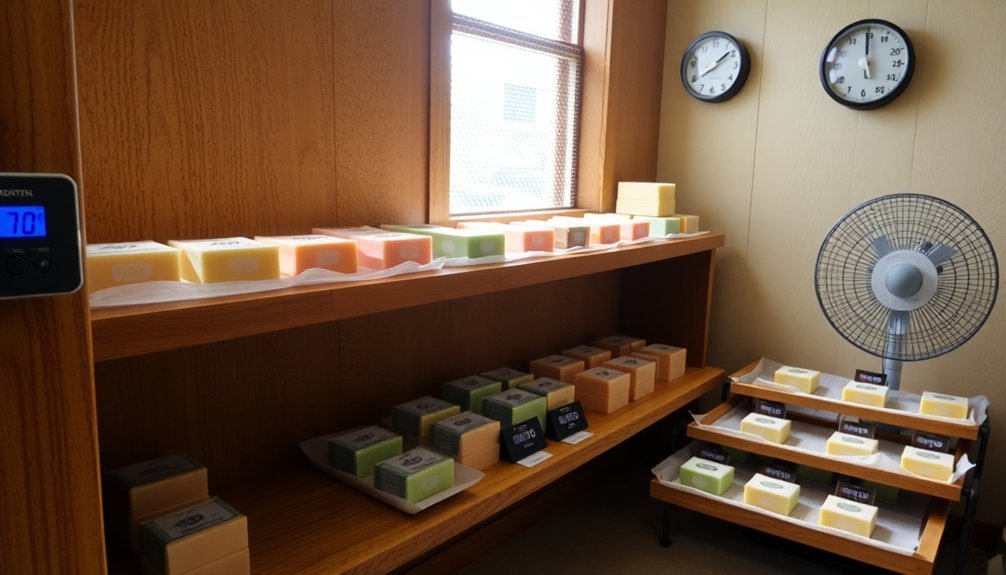
To maximize the quality of your cold process soap, establishing a dedicated temperature-controlled curing space stands as one of the most important investments you'll make.
The ideal environment maintains temperatures between 70-85°F (21-30°C) with humidity levels of 50-60%.
Effective temperature control requires:
- Proper insulation – Use foam board or reflective materials to shield your curing area from external temperature fluctuations.
- Ventilation systems – Install fans for consistent air circulation to prevent moisture buildup.
- Monitoring equipment – Deploy digital thermometers and hygrometers to track conditions.
- Appropriate shelving – Arrange soap bars with space between them on removable shelves for maximum airflow.
Higher temperatures significantly increase water evaporation rates, which can accelerate the curing process beyond what's optimal for complete crystallization.
Consider energy-efficient heating or cooling units for extreme climates, and minimize direct sunlight which can cause uneven curing and discoloration.
How Temperature Impacts Curing Time and Efficiency
Temperature plays an essential role in determining how quickly your soap cures, with ranges between 70°F-85°F (21°C-29°C) offering ideal evaporation without compromising soap quality.
You'll notice faster water evaporation at higher temperatures, though this won't greatly reduce the standard 4-6 week curing period needed for proper saponification.
As seasons change, you'll need to adjust your curing environment—using dehumidifiers in humid summers and avoiding overly dry conditions in winter that might cause excessive cracking. This curing process follows the initial cold process method, which begins by mixing oils with a lye solution at temperatures between 80-120 degrees Fahrenheit.
Ideal Temperature Ranges
Finding the ideal temperature range for curing cold process soap greatly impacts both the quality and efficiency of your final product. For best results, you'll want to maintain temperatures between 65°F and 75°F throughout the curing process. This range guarantees even drying without compromising fragrance integrity or causing excessive moisture retention.
Your soap's curing environment should feature:
- Consistent temperature – avoid fluctuations that can cause uneven curing
- Low humidity levels – prevents moisture from becoming trapped in your soap
- Good air circulation – helps maintain uniform drying across all soap surfaces
- Protection from direct heat sources – prevents overheating which can make soap brittle or cause fragrance degradation
While cooler temperatures slow the process, they often yield harder, longer-lasting bars. Higher temperatures may speed curing but risk quality compromises.
Seasonal Curing Adjustments
Wherever you live, seasonal changes dramatically affect your cold process soap curing process.
Summer's high humidity slows evaporation, extending curing times despite warmer temperatures. Winter cooling may lengthen curing but often produces harder, more stable bars.
You'll need different approaches for each season. In summer, use fans to improve circulation and counter humidity. Saponification is exothermic, generating heat that can affect your curing environment, especially in warmer months.
During winter, maintain airflow while preventing extreme temperature drops that inhibit proper curing.
Spring and fall typically offer ideal conditions with moderate temperatures and humidity.
Your soap's environment matters as much as the season. Guarantee consistent air circulation by properly spacing bars.
Consider using hygrometers and thermometers to monitor conditions, especially if you're in a region with extreme climate variations.
Regularly check your soap's progress and adjust your curing time expectations according to your local seasonal patterns.
Temperature Effects on Soap Colorants and Fragrance
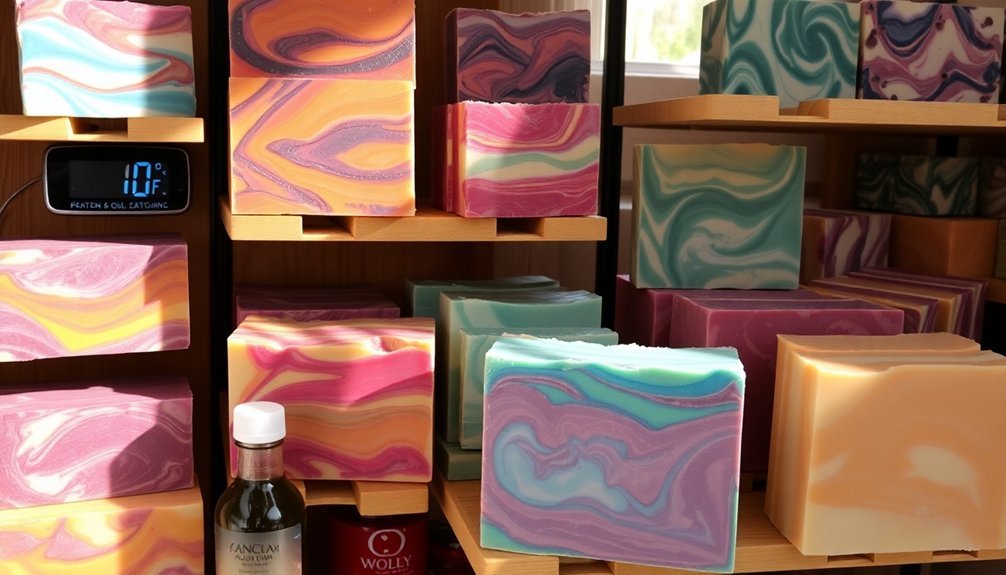
How does heat transform the visual appeal and aromatic profile of your handcrafted soaps? Temperature management during curing greatly impacts both color vibrancy and scent retention. Higher temperatures intensify colors, especially during gel phase, but can accelerate fragrance evaporation.
When balancing temperature effects, consider:
- Color stability – Natural pigments are heat-sensitive, while LabColors benefit from higher temperatures.
- Fragrance retention – Cooler temperatures preserve volatile essential oils better than synthetics.
- Gel phase management – Controlling heat enhances color brightness but may affect scent longevity.
- Environmental factors – Room temperature influences overall curing, affecting both color development and fragrance binding.
Your thermometer becomes a crucial tool in this delicate balance, as consistent temperature monitoring guarantees replicable results across batches for both visual appeal and aromatic quality. Recipes containing solid oils require more precise temperature control to prevent issues like false trace or separation during the curing process.
Scientific Explanation: Why Temperature Matters During Curing
While many soapmakers focus on ingredients and techniques, the molecular transformation occurring during curing depends critically on temperature control. Temperature affects the saponification reaction at its core—the process where lye and oils combine to create soap. When you maintain proper temperature, you're ensuring this chemical reaction completes fully.
| Temperature Range | Effect on Curing | Best For |
|---|---|---|
| 60-65°F (15-18°C) | Slower curing, better mold release | Milk soaps, delicate additives |
| 70-75°F (21-24°C) | Balanced curing speed, ideal hardness | Most soap formulations |
| 80-85°F (27-29°C) | Accelerated curing, enhanced gel phase | Vibrant colors, faster production |
| 90°F+ (32°C+) | Potential overheating, glycerin rivers | High olive oil soaps |
Temperature consistency matters just as much as the actual temperature. Fluctuations can lead to uneven curing, affecting your soap's quality and longevity.
Troubleshooting Temperature-Related Curing Problems
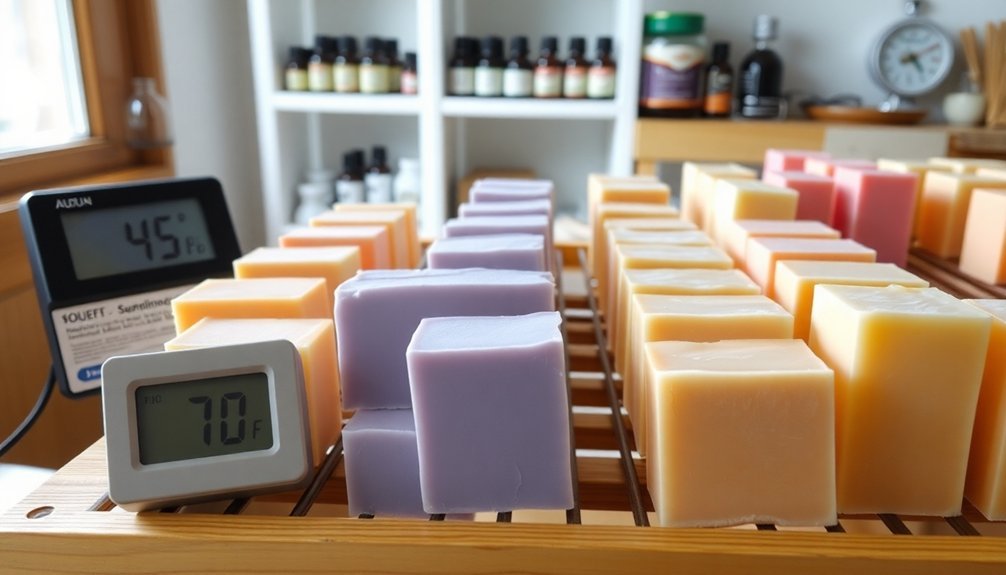
Even the most carefully measured soap recipe can develop issues when temperature goes awry during curing.
You'll notice glycerin rivers, cracking, or volcanoing when your soap overheats, while cooler temperatures can result in incomplete saponification and duller colors.
Monitor both soap and room temperature with a thermometer, as environmental conditions greatly impact curing. Keeping temperatures within the optimal range of 70°F to 110°F (21°C to 43°C) ensures proper saponification without common defects.
Adjust your approach based on your specific recipe—milk soaps need cooler temperatures, while beeswax requires more heat.
To fix temperature-related problems:
- Use cold water baths to cool overheated batches
- Remove insulation in warm environments to prevent overheating
- Increase insulation in cooler rooms for proper gel phase
- Consider refrigerating temperature-sensitive recipes with high coconut oil content
Remember that appearance issues rarely affect soap safety, just aesthetics.
Frequently Asked Questions
Can I Cure Soap in My Refrigerator to Speed up Hardening?
No, you shouldn't cure soap in your refrigerator. It won't speed up hardening properly as refrigerators have high humidity and poor air circulation. You'll actually slow down moisture evaporation, extending your curing time instead.
Will My Soap Cure Differently at High Altitudes?
Yes, your soap will cure differently at high altitudes. You'll notice faster water evaporation due to drier air. Monitor your soap more frequently to prevent over-drying, but you won't typically need to make specific altitude adjustments.
How Does Bathroom Humidity Affect Stored Cured Soap?
Bathroom humidity can ruin your cured soap by causing glycerin dew, making it sweat, and shortening its lifespan. You'll notice reduced durability and deteriorating appearance. Consider storing your soap elsewhere or using airtight containers with desiccants.
Can I Use a Dehumidifier in My Soap Curing Area?
Yes, you can use a dehumidifier in your curing area. It'll reduce humidity, preventing DOS and improving soap firmness. Just make sure it doesn't replace proper air circulation, as both are essential for ideal soap curing.
Does Curing Temperature Affect the Shelf Life of Soap?
Curing temperature doesn't directly affect your soap's shelf life. Your soap's formulation and storage conditions matter more. While excessive heat might slightly accelerate oxidation, properly cured soap will last years regardless of curing temperature.
In Summary
Maintaining your cold process soap's curing temperature between 65-75°F (18-24°C) is essential for ideal results. You'll notice better color retention, stronger scent profiles, and proper saponification when you keep the environment stable. Don't worry if temperatures fluctuate slightly—your soap is resilient. Just avoid extremes that might cause sweating or delayed curing. Remember, consistent temperature control is the key to achieving that perfectly cured bar you're working toward.

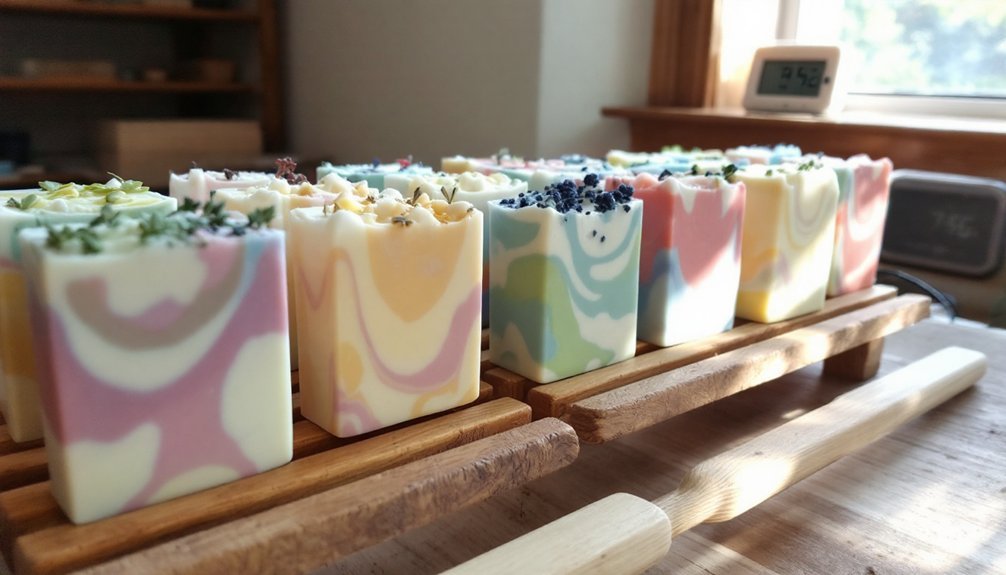



Leave a Reply